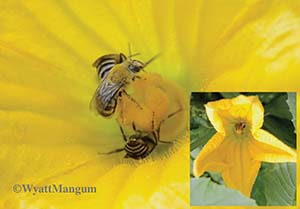
The spring flowers have withered away, typical for a late June dearth in Piedmont Virginia. As the heat of the summer begins to surge, the bee flight in my apiaries has waned from the zeal of the spring nectar flow. Now in the mornings, the bees begin collecting water to cool their hives. I know the rhythm of their work, and their gentle working hum. Except for one apiary in a shady cool wooded location.
From a hole in the dark leaf canopy above the apiary, bees fly down, bulging full, mimicking a light rain, from the patch of cloudless blue sky above. Stuffed full of nectar that will never make honey, having discarded their pollen except for trace bits, I know for certain — my bees have found a squash field.
Yes, the gentle rain of incoming bees has been off somewhere pollinating a farmer’s squash crop. Technically this kind of pollination is called spill-over pollination. It is pollination provided by beekeepers, but they cannot charge for the service because bees forage freely. While bees may forage up to five or six miles (the estimates vary and depend on the situation), they do not travel far for squash nectar. After tracking my forager bees and eliminating their choices (locations), I quickly find a large squash field, hardly a quarter mile from the apiary (see Figure 1).
Between my apiary and the squash field, the bees had to fly across a fairly busy highway, an immediate concern for me. I have seen where bees get killed quite frequently by fast-moving traffic, although the evidence, dead bees by the road, is difficult to detect. Helping to reduce fatalities were the mature oak climax trees, forcing the bees to fly up and then down the hole in the leaf canopy to their hives. It seemed the bees would fly high enough over the highway too, and avoid the traffic, even the large trucks.
Every morning while the squash field bloomed, thousands of diligent and dedicated foraging bees flew for the large squash field where thousands of large yellow flowers bloomed. To see the flowers and bees, I found thinner places in the field, breaking open the broad green leaf canopy covering most of the flowers. Patrolling the wider rows became quite valuable too (see Figures 2 and 3).
As the field begins to bloom, the first flowers are virtually all male. Figure 4 shows a cut-open male squash flower. This flower produces only pollen. The pollen comes from the anthers, the compressed-appearing crown of the tree-like structure in the center of the flower. Squash pollen grains are large and sticky, definitely not adapted for movement by the wind. Nothing like, for example, the pine pollen in the spring that floats like a fine dust, turning windshields a faint yellow in the spring. Squash pollen needs some agent to transport its pollen.
For many centuries, long before the arrival of Europeans, the primary agents were Squash bees (of the genera Peponapis and Xenoglossa). Squash bees remain valuable pollinators that specialize their foraging on squash, in addition to pumpkins and gourds. Figure 5 shows squash bees (Peponapis) in gourd flowers. Beginning in the recent past for commercial squash production, honey bees are usually the predominant pollinators since we can boost their number of foragers to meet the intensive flower demands of the field.
In general, the pollinating bee picks up pollen from the anthers when climbing over them to collect nectar at the base of the male flower. To identify the male gender of an intact squash flower, look at its stem. Male flowers have a thin regular-appearing stem behind the flower (see Figure 4). Presumably the male initial bloom attracts pollinators to learn the field location and begin foraging in it, so they meet the female flowers when they soon bloom.


